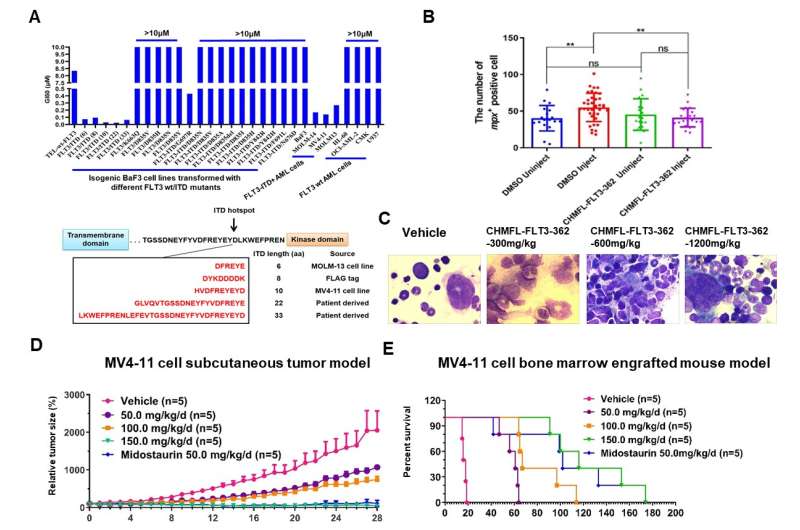Scientists discover a novel FLT3-ITD mutant selective inhibitor

Recently, a research team led by Dr. Liu Qingsong and Dr. Liu Jing from High Magnetic Field Laboratory of the Chinese Academy of Sciences has discovered a novel FLT3-ITD mutation-selective kinase inhibitor CHMFL-FLT3-362, a third-generation FLT3 kinase inhibitor.
In 30 to 40% of acute myeloid leukemia (AML) patients, FLT3 gene acquires an internal tandem duplication mutation in the juxtamembrane domain of FLT3 (FLT3-ITD), which is associated with poor prognosis. However, wild-type FLT3 (FLT3 wt) kinase plays important roles in the differentiation and survival of hematopoietic stem cells in bone marrow.
As a result, most of the current FLT3 kinase inhibitors such as Gilteritinib, Crenolanib, Quizartinib and Midostaurin, which cannot distinguish the structurally similar cKIT kinase and FLT3 wt kinase, might lead to myelosuppression toxicity.
Therefore, in order to avoid the adverse effects caused by the inhibition of FLT3 wt and cKIT kinases, researchers seek small-molecule inhibitors that can selectively target FLT3-ITD mutations.
The team developed a novel third-generation FLT3-ITD mutant selective inhibitor CHMFL-FLT3-362, which achieved 30-fold selectivity between FLT3-ITD mutants and FLT3 wt in biochemical assays and 10-fold selectivity in a cellular context.
Furthermore, it also achieved great selectivity over cKIT kinase, which would help to avoid the myeloid suppression toxicity due to the FLT3/cKIT dual inhibition.
Compared to Midostaurin, CHMFL-FLT3-362 caused tail curvature in zebrafish models much less than Midostaurin did at 1 μM concentration.
In the subcutaneous MV4-11 cells xenograft mice model, CHMFL-FLT3-362 displayed dose-dependent anti-tumor efficacy and achieved the tumor growth inhibition (TGI) of 95% at 150 mg/kg/day dosage. In the bone marrow engrafted mice model, CHMFL-FLT3-362 dose-dependently extended the survival of mice at 50, 100, and 150 mg/kg/day dosages with no apparent weight loss at all dosages.
These results suggested that CHMFL-FLT3-362 was a novel research tool for FLT3 mediated pathological study as well as a novel anti-FLT3-ITD+ AML drug candidate.
This work was currently published online in the journal of Haematologica, titled "Selectively targeting FLT3-ITD mutants over FLT3-wt by a novel inhibitor for acute myeloid leukemia."
More information: Aoli Wang et al. Selectively targeting FLT3-ITD mutants over FLT3-wt by a novel inhibitor for acute myeloid leukemia, Haematologica (2020). DOI: 10.3324/haematol.2019.244186
Provided by Chinese Academy of Sciences



















